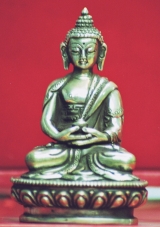
In the serene realms of Buddhist meditation practice, the altar stands as a focal point for devotion, contemplation, and spiritual connection. Adorned with symbolic representations, a Buddhist shrine or altar is a microcosm of profound teachings. Central to this sacred space are the three pillars of Buddhist practice: body, speech, and mind. In this exploration, we delve into the intricate details of how these essential components find expression on a Buddhist altar.
Body: The Tangible Manifestations

At the forefront of a Buddhist altar's physical representation is the embodiment of enlightened beings. Statues or images of Buddhas, Bodhisattvas, daka's, dakinis, dharmapala's, and protectors are carefully arranged to embody the principles of compassion, wisdom, and other virtues. Each figure is meticulously crafted, reflecting the physical aspects of the enlightened state. The posture, mudras (hand gestures), and facial expressions of these representations are not merely artistic choices but convey profound spiritual messages. The presence of offerings such as flowers, candles, and incense further emphasizes the physicality of the body aspect. These tangible elements symbolize wisdom and compassion, demonstrated by the life example of beings that have transcended samsara. The body representation of enlightenment is also a reminder of impermanence, the fleeting nature of life, and the importance of cultivating mindfulness in the present moment.
Speech: The Resonance of Sacred Sound

Speech, in the context of a Buddhist altar, is represented by the dharma, as conveyed by sacred texts, mantras, and prayers, wrapped up and placed on the altar. Positioned alongside the statues, the texts, or scriptures, serve as tangible reminders of the power of speech in fostering a connection with the enlightened state of mind. The dharma texts which are placed on the altar to represent the quality of enlightened speech are often wrapped in silk brocades, or other decorative cloths, to honor their sacred and profound meaning. The rhythmic recitation of mantras generates positive vibrations, harmonizing the space and resonating with the spiritual energy of the altar. In some traditions, musical instruments like bells, drums, and conch shells are also included. These instruments symbolize the orchestration of the Dharma, the universal truth, echoing through the cosmos. The melodic resonance serves as a reminder of the interconnectedness of all beings and the potential for enlightenment through the harmonization of one's speech with the teachings of the Buddha.
Mind: The Inner Sanctum of Contemplation

The mind, as represented on a Buddhist altar, is the essence of contemplation and meditation. Often at the center of the altar is a crystal ball, or a statue of a stupa—a symbolic structure representing the enlightened mind. This central focus prompts practitioners to turn inward, emphasizing the importance of cultivating a tranquil and focused mind through meditation. A crystal ball represents the clarity and purity of enlightened mind, which is (Buddha nature) the essential nature of all beings.
Offerings such as water, flowers, food, incense, purfume, musical instruments and others demonstrate generosity and a willingness to surrender anything that is enjoyable as a sensual pleasure as an offering to enlightenment as demonstated by the Buddha. Mirrors, which reflect the true nature of reality, are placed strategically to encourage introspection. The mind aspect of the altar serves as a constant invitation to explore the depths of one's consciousness and connect with the universal truths embedded in Buddhist teachings.
Conclusion: A Buddhist altar is not just an arrangement of objects; it is a sacred stage where the interplay of body, speech, and mind unfolds. As practitioners engage with the physical representations, recite sacred texts, and immerse themselves in meditation, they embark on a journey towards enlightenment. The altar becomes a microcosm of the path to awakening, a tangible reminder of the profound teachings encapsulated in the trinity of body, speech, and mind. In the stillness of the altar, the practitioner finds a sanctuary where the sacred dance of these three elements harmonizes, paving the way for spiritual transformation.